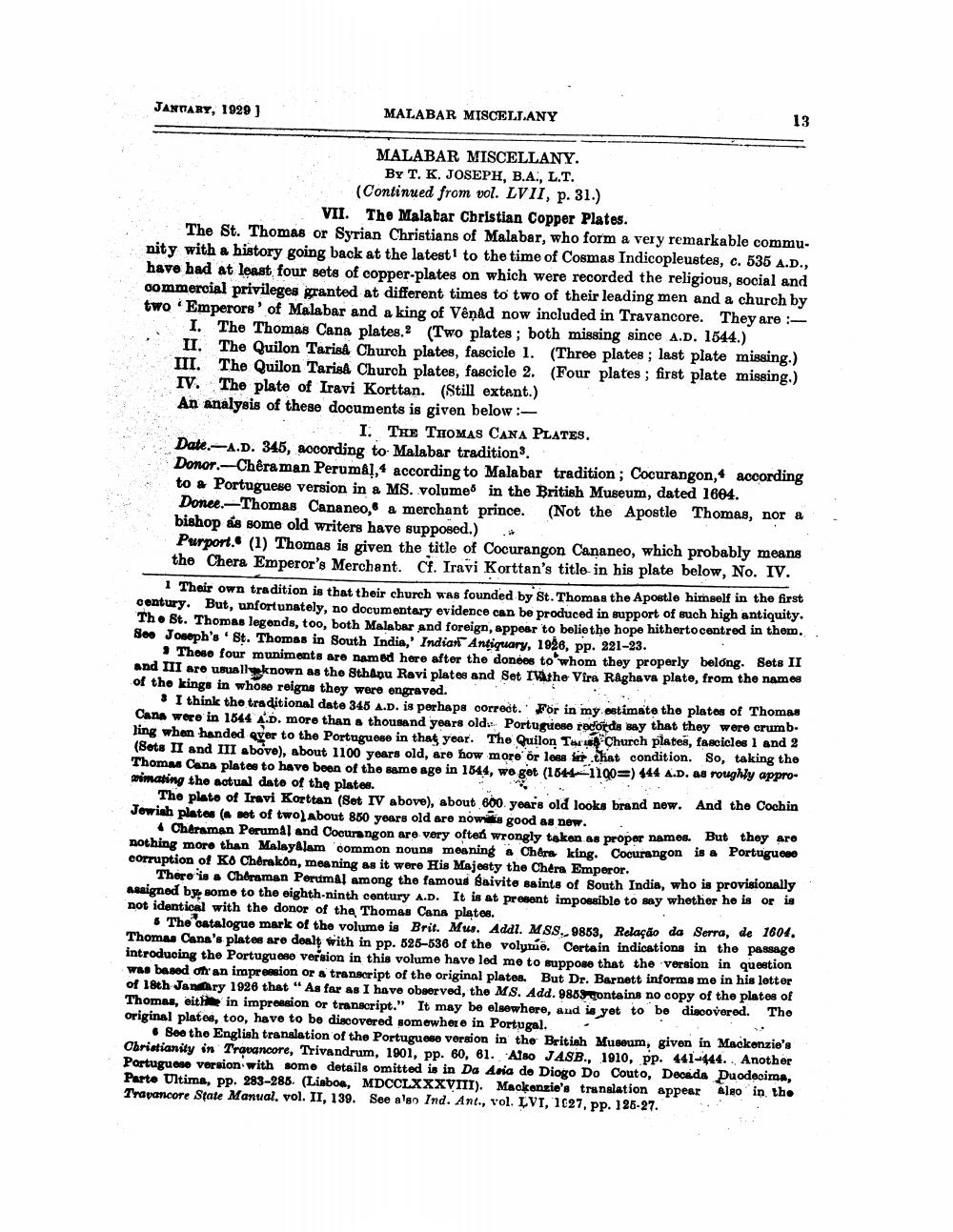________________
JANUARY, 1929]
MALABAR MISCELLANY
MALABAR MISCELLANY. By T. K. JOSEPH, B.A., L.T. (Continued from vol. LVII, p. 31.)
13
VII.
The Malabar Christian Copper Plates.
The St. Thomas or Syrian Christians of Malabar, who form a very remarkable community with a history going back at the latest to the time of Cosmas Indicopleustes, c. 535 A.D., have had at least four sets of copper-plates on which were recorded the religious, social and commercial privileges granted at different times to two of their leading men and a church by two Emperors' of Malabar and a king of Vênâd now included in Travancore. They are:I. The Thomas Cana plates.2 (Two plates; both missing since A.D. 1544.) (Three plates; last plate missing.) (Four plates; first plate missing.)
II. The Quilon Tarisa Church plates, fascicle 1. III. The Quilon Taris& Church plates, fascicle 2. IV. The plate of Iravi Korttan. (Still extant.) An analysis of these documents is given below:I. THE THOMAS CANA PLATES. Date.-A.D. 345, according to Malabar tradition3. Donor.-Chêraman Perumal, according to Malabar tradition; Cocurangon, according to a Portuguese version in a MS. volume in the British Museum, dated 1604. Donee.-Thomas Cananeo, a merchant prince.
(Not the Apostle Thomas, nor a
bishop as some old writers have supposed.) Purport. (1) Thomas is given the title of Cocurangon Cananeo, which probably means the Chera Emperor's Merchant. Cf. Iravi Korttan's title in his plate below, No. IV.
1 Their own tradition is that their church was founded by St. Thomas the Apostle himself in the first century. But, unfortunately, no documentary evidence can be produced in support of such high antiquity. The St. Thomas legends, too, both Malabar and foreign, appear to belie the hope hitherto centred in them. See Joseph's St. Thomas in South India,' Indian Antiquary, 1926, pp. 221-23.
4
These four muniments are named here after the donées to whom they properly belong. Sets II and III are usually known as the Sthapu Ravi plates and Set IVathe Vira Raghava plate, from the names of the kings in whose reigns they were engraved.
I think the traditional date 345 A.D. is perhaps correct. For in my estimate the plates of Thomas Cana were in 1544 A.D. more than a thousand years old. Portuguese records say that they were crumb. ling when handed over to the Portuguese in that year. The Quilon To Church plates, fascicles 1 and 2 (Sets II and III above), about 1100 years old, are how more or less ir that condition. So, taking the Thomas Cana plates to have been of the same age in 1544, we get (15441100=) 444 A.D. as roughly approwimating the actual date of the plates.
The plate of Iravi Korttan (Set IV above), about 600 years old looks brand new. And the Cochin Jewish plates (a set of two) about 850 years old are nows good as new.
Cheraman Perumal and Cocurangon are very often wrongly taken as proper names. But they are nothing more than Malayalam common nouns meaning a Chêra king. Cocurangon is a Portuguese corruption of Ko Cherakon, meaning as it were His Majesty the Chera Emperor.
There is a Cheraman Perumal among the famous saivite saints of South India, who is provisionally assigned by some to the eighth-ninth century A.D. It is at present impossible to say whether he is or is not identical with the donor of the Thomas Cans plates.
The catalogue mark of the volume is Brit. Mus. Addl. MSS. 9853, Relação da Serra, de 1604. Thomas Cana's plates are dealt with in pp. 525-536 of the volume. Certain indications in the passage introducing the Portuguese version in this volume have led me to suppose that the version in question was based on an impression or a transcript of the original plates. But Dr. Barnett informs me in his letter of 18th Janary 1926 that "As far as I have observed, the MS. Add. 9853 contains no copy of the plates of Thomas, eithe in impression or transcript." It may be elsewhere, and is yet to be discovered. The original plates, too, have to be discovered somewhere in Portugal.
See the English translation of the Portuguese version in the British Museum, given in Mackenzie's Christianity in Travancore, Trivandrum, 1901, pp. 60, 61. Also JASB., 1910, pp. 441-444. Another Portuguese version with some details omitted is in Da Asia de Diogo Do Couto, Decada Duodecima, Parte Ultima, pp. 283-285. (Lisboa, MDCCLXXXVIII). Mackenzie's translation appear Travancore State Manual. vol. II, 139. See also Ind. Ant., vol. LVI, 1027, pp. 125-27. also in the




